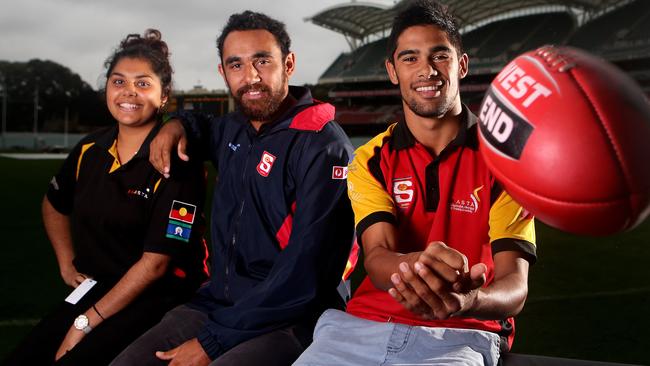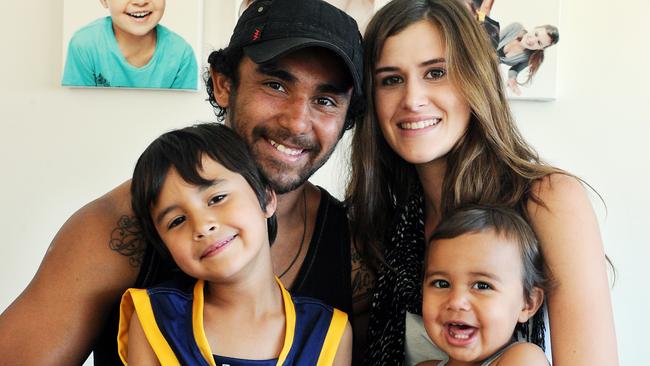Proud Richard Tambling reflects on his journey from living under a tree to playing in the AFL
RICHARD Tambling can’t stop smiling. Nine months removed from his last AFL game, the former Crow is in a happy place.

Local Footy
Don't miss out on the headlines from Local Footy. Followed categories will be added to My News.
RICHARD Tambling can’t stop smiling.
At age 27 and nine months removed from his last AFL game in a career dogged by living in Lance Franklin’s shadow, Tambling is in a happy place.
“Now I am a dad and I think about where I came from I don’t really care about the critics that have come at me and hyped this story about Franklin being taken a pick behind me,’’ Tambling said.
“It bothered me during my (football) career but it doesn’t bother me anymore because I believe that from where I started I have achieved more than anyone could hope to achieve.
“I’ve given a great life to my two children (Tyson, 8, and Leah, 5) and my partner (fiancee) Amy.
“From living under a tree to being able to support them and give them a house to live in, to be able to buy them birthday presents, Christmas presents and Easter eggs, things I never got as a kid, I’m just so proud of it.
“It just shines in my face when I speak about things like that.’’
Tambling - famously taken by Richmond a pick ahead of former Hawk and current Swans superstar forward and $9 million man Franklin at No. 4 at the 2004 national draft - says he had an upbringing “as tough as any player’’ in VFL-AFL history.
“I lived under a tree, which in itself is a pretty amazing thing,’’ he said.
While the speedy midfielder never lived up to his pick four billing in a draft which saw those selected around him - Tiger Brett Deledio (pick one), Hawk Jarryd Roughead (two), Bulldog Ryan Griffen (three), Franklin (five) and Hawk Jordan Lewis (seven) - become stars, Tambling played 124 AFL games, including 108 for Richmond from 2005-10 and 16 with Adelaide from 2011-13.
Upon reflection, the man who is now playing a key on-field role in Sturt’s renaissance and is working for the SANFL as a diversity programs co-ordinator where he mentors 15 trainees, is more than happy with his lot.
“Unrealistic expectations were put on me from the start because of the success of Buddy (Franklin),’’ Tambling said this week as he spoke to his trainees about the significance of this weekend’s SANFL Indigenous Round.
“Buddy is a freak, he’s one of the greatest players of all-time, and for a young boy like me to have to live up with those comparisons wasn’t easy and it did affect me.
“But that’s all in the past. When I look at what I’ve achieved from where I’ve come from I’m just so happy.
“I look at myself as a success, not a failure.’’
THE UPBRINGING
Tambling was raised by his grandmother, Barbara, from the age of nine months and spent the next two years of his life living under a Leichhardt tree at Humpty Doo Station, 50km from Darwin.
His mum, Jennifer, gave birth to him at age 17 and his dad wasn’t around, leaving his grandma to look after him.
“We pretty much lived underneath a Leichhardt tree fitted with mosquito nets for two years,’’ Tambling recalled.
“Grandma’s partner, Eddie, lived with us and she saw fit to give up being an alcoholic to raise me and I am just so grateful for that.
“Obviously, being so young, I can’t remember too much about life under the tree but other family members tell me how she used to rake the sand every morning and afternoon just to make sure it was clean enough for me to crawl on.’’
THE BUSH EXPERIENCE
Tambling’s grandma moved him to the Fifty Mile Creek Aboriginal Community - a transit centre for Indigenous workers - when he was aged three.
He lived there with her until he was about 13 and played football with kids in the street for fun.
But for between four-to-six months every year, Tambling would head deep into the bush with Barbara, where he was taught the way of the land and how to hunt and fish.
“I didn’t go to school because we were living 120km from the nearest school and didn’t have a car,’’ Tambling explained.
“So we would get dropped out in the bush and Nanna would do her best to teach me the traditional ways. For a person who can’t read or write, she’s done a brilliant job with not only raising me but other kids along the way too.
“She’s still the queen of the (Fifty Mile Creek) community and I make a point of seeing her every time I’m in Darwin.’’
THE FOOTBALL JOURNEY
Tambling’s natural football talent and athleticism was spotted early.
But he says without the help of “several people’’, it would have been confined to Northern Territory streets rather than the greatest football grounds in the country.
“When I moved to Kakadu to live with my mum for a couple of years when I was about 13 the Southern District under-14s coach, Gary Masters, was so keen for me to play in his side he took it upon himself to drive 250km on a Friday afternoon to pick me up,’’ Tambling said.
“He’d take me into town to play for his team and live at his house for a couple of days, do a bit of schooling and then drive me back out.
“And if he couldn’t pick me up he’d make sure he’d raise the money for me to catch the bus in.
“There were others that helped me along the journey too and when I took up a football scholarship with the NT Institute of Sport at age 15 that’s where my beliefs of perhaps becoming an AFL footballer took the next step.”
THE FAMILY
“I’ve always stayed in contact with mum. She remarried and now I’ve got three younger brothers who live with her in Kakadu,’’ Tambling said.
“I didn’t meet my dad until I was in my early 20s and that was by chance.
“Someone overhead me telling a friend on a school bus that I didn’t know my dad and later that day the Aboriginal liaison officer from our school was running towards me with tears in her eyes,
“She cuddled me and told me she was my grandma on my dad’s side. I’d been at that school (Dripstone High) for three years and had no idea we were related.
“I met my dad, who lives at One Arm Point near Broome (WA), a few years later.’’
WHAT MIGHT HAVE BEEN
Tambling says without his grandma’s influence, he would probably be in jail, or even dead.
“It sounds dramatic but without my grandma looking after me and then whipping me back into line when I did get in trouble, I probably would have ended up staying back in the community, being an alcoholic and, worst of all, wound up dead,’’ he said.
“I lived in a community where at the time there was drugs, violence and alcohol, all sorts of things that can go on in community life, and even under her guidance I got into trouble with the cops.
“My grandma was the driving force behind me leaving the community because she didn’t want me to turn out like a lot of other people she saw go down the wrong pathways.’’

GIVING YOUNG INDIGENOUS PLAYERS A CHANCE AT BIG TIME
“FROM where that boy’s come from to be able to play league footy is a good story in itself.’’
That’s how Richard Tambling’s first AFL coach Terry Wallace described his debut performance for Richmond in 2005.
Tambling is now telling his remarkable rags-to-riches tale to help inspire the 15 trainees he is working with in his role as SANFL Diversity Programs Co-ordinator.
“These young people have been given a great opportunity in life,’’ Tambling said.
“They have faced - and still face - the difficulties of growing up. We’ve got a couple of community kids among our trainees and some of them still have to learn the western way of life and new ways of communicating.
“In this program they are learning life skills and how to become young adults and pursue better things for their lives.’’
The SANFL Traineeship program is open to male and female indigenous young people who have completed SACE through an SA Aboriginal Sports Training Academy (SAASTA).
Successful applicants undertake a 12-month traineeship, including employment, a nationally-recognised certificate and further training and development incorporating TAFE, University and professional sporting and/or training pathways.
Tambling said his young trainees were unaware of the hardships he grew up with and that since he had revealed his upbringing they had asked for more advice.
One is even doing a school project on his incredible rise from tree dweller to role model.
“Not too many people know the ins and outs of my life,’’ Tambling said.
“I don’t like to tell people too much about it but I’ve had a couple of conversations with the trainees and one is so amazed he is telling my story for his school project.’’
A key part of the SANFL’s Indigenous Round will unfold before Saturday’s Eagles-Crows clash at Woodville Oval, where the state’s best Indigenous players aged under 15 (the SA Kickstart team) will tackle the Eagles under-16s.
Tambling said his son, eight-year-old Tyson, doesn’t play football but could have an exciting future as an athlete.
Tambling - enjoying a strong season for Sturt - takes his son to his games but rather than watch, Tyson does his best Forrest Gump impersonation and spends the afternoon running laps of the oval.
“He just does lap after lap, he loves it,’ Tambling said. “So we’ll see where that takes him.’’



